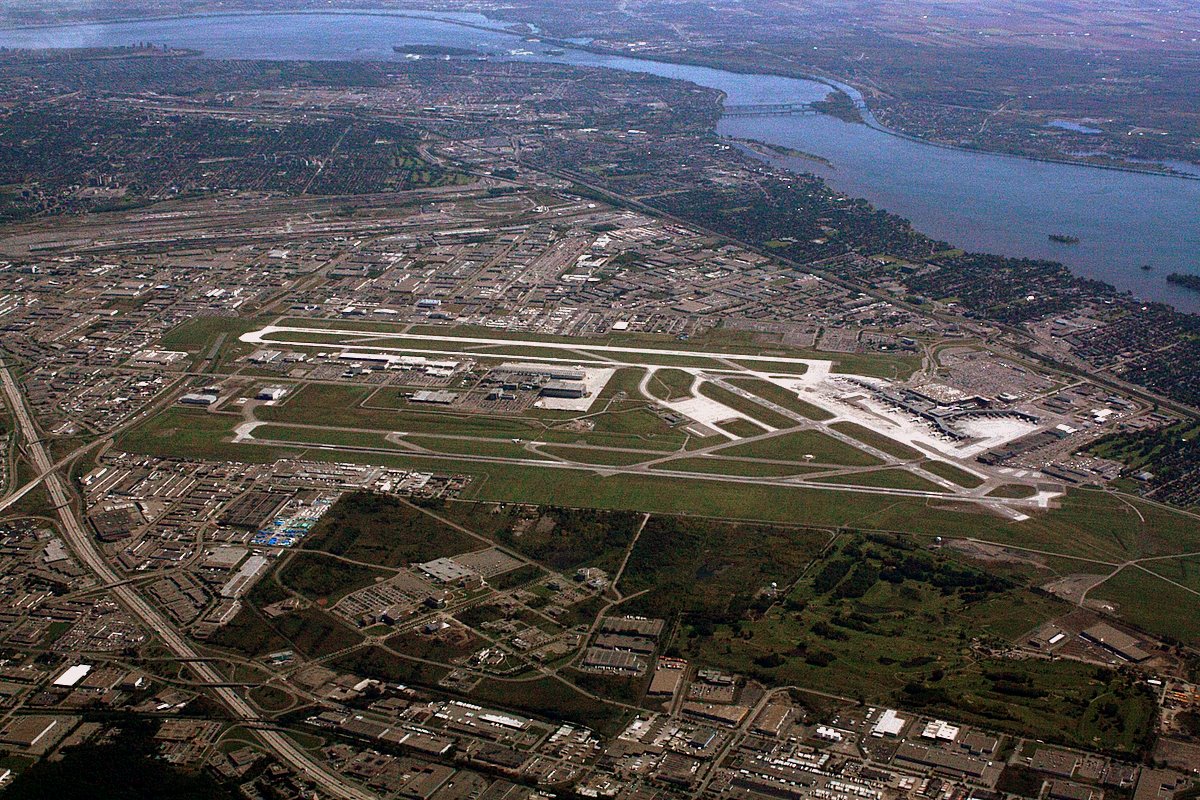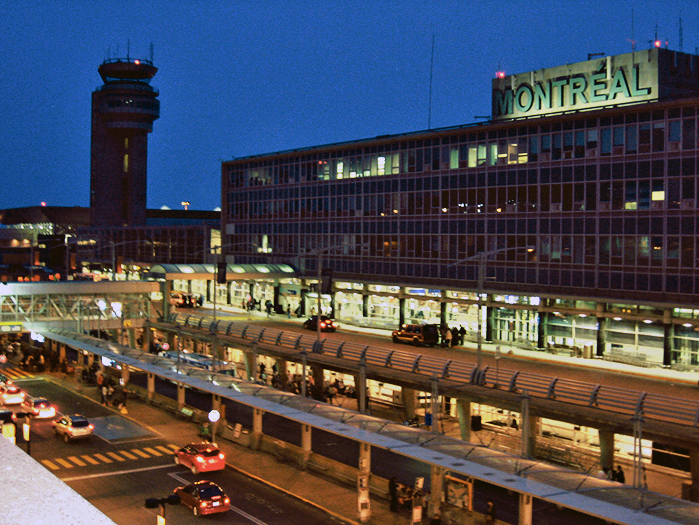I trace the route home from the sky. Follow the St. Lawrence River from the west—spot the bridge to the USA in Cornwall, where my dad now lives—over onto the Island of Montreal, then over Mount Royal, swinging back west when we get over the Olympic Stadium, over the 13 highway, then land, at Pierre Elliott Trudeau International Airport, Montreal’s airport, YUL.
Bienvenue à Montréal. Veuillez s’il-vous-plaît patienter . . .
Before they turn to English, the flight attendants address us in French, per the law. I’m home.
When people ask me where I grew up in Montreal, I ask them if they’ve ever flown into the city. If they have, they probably flew over the red-roofed house on Lakeshore Road, the paths along Lake Saint-Louis where I used to ride my bike in the summer. Before YUL was Trudeau airport, it was Dorval, named after the suburban city it is located in. The place where I grew up.
I text my mom, letting her know that I’ve landed, that she should come pick me up. She still lives in that same house I grew up in. As we wait to disembark, the plane, like any plane that lands at YUL, fills with the chatter of Québécois French, not to mention Lebanese, Arabic, Greek, Italian, even Yiddish.
The trip from International Arrivals to Customs is more than a kilometer long. When I fly with my kids, I usually take the golf cart shuttle with them, but I am alone, so this time I walk, dragging my carry-ons behind me. After I’ve been sitting for so long, the walk feels good at first; suddenly, all at once, a kilometer becomes a very long distance to cover. The signs are in French first, as are the PA announcements, and Customs is Canadian—not Québécois—so they can and do greet you with a “Bonjour-Hi.” Sometimes, depending on how I’m feeling about the accent—mine, theirs—and if I’m by myself, I’ll answer in Québécois, a way to hopefully make things easier.
Dorval airport was never supposed to grow this large. In 1975 they built Mirabel (YMX) about an hour north of the island, assuming the city would grow out that way. Instead the city grew to the south, and since no one wanted to drive off the island, Dorval—itself built in 1941 to replace the city’s original airport, Saint-Hubert (YHU)—has remained the go-to Montreal airport, accompanied in time by the suburbs that have grown up against it. At one point, Dorval airport was one of the biggest in the world, Europe’s gateway to Canada, though it’s been many times surpassed by Toronto Pearson (YYZ) now; so many regional headquarters left Quebec in the wake of the increasingly stringent language laws, not to mention the uncertainty around sovereignty. Even so, Dorval has continued to grow, much to the consternation of the residents of the surrounding municipalities.
Having grown up in Dorval, my attitude was always, Look, you knew where you were buying your house. There’s a reason it was cheaper than other places. It’s also the reason our municipal taxes are lower, yet the services are excellent. The airport pays for those pools, those rinks, the library, the sports fields.
I should know: in the summertime I worked at one of those public pools, built almost at the end of a runway. When I taught swimming lessons, I could tell which kids had parents who grew up around Dorval and which didn’t: some didn’t flinch when a plane screamed overhead, and some would cringe and cover their ears. Adult lifers would keep chatting, just a little louder, or knew exactly how long to pause before the noise died down. I still know, when I am on the phone with my mom, in the spring or fall, when the AC isn’t on and the windows are open, how long to pause, and how much time we will have between interruptions.
My dad worked for Air Canada, as did two of our next-door neighbors, and the parents of my three best friends in high school worked for Air Canada, the now-defunct Canadian Airlines, and the airport authority. My dad worked a lot of different jobs over the course of his career, but the one I remember, the one he did the longest, was “aircraft router.” He and the team he worked on were responsible for scheduling which airplane would complete which route, keeping in mind things like maintenance requirements according to mileage, as well as where a plane was at any given moment. Because of union agreements, certain routine maintenance could only be done at certain airports, so my Dad had to make sure that the plane got where it needed to go at the right moment.
We used to watch the planes take off on the summer evenings. My dad knew the Air Canada planes by heart and trained us to read the serial number off the bottom of the plane. We would watch the giant 747s take off for their red-eye flights to Europe, and when Formula 1 weekend would come along, we would spend the Sunday afternoon after the race watching the private planes return to whatever exotic locale they had arrived from.
I remember waiting outside, in the winter, for my ride to morning swim-team practice, hearing as the morning’s first flights to Toronto and New York took off.

I wish I could find a picture of what the airport facade looked like during the day, so you could see the iconic teal-green panels that lined the front of the terminal building. New pictures of the new airport show you a hotel, renovated terminals, all bright and shiny and modern. I prefer the old facade, the old colors that dated the airport so wonderfully, back to when Montreal was really something: Expo ’67, the 1976 Olympics. My dad worked in the offices above the terminal for a time, and I can remember going into the office to pick something up or drop something off, being amazed that I had gone beyond the usual Departure and Arrival levels. Once I got up there, it was just an office, but I could never quite shake the feeling that it was in the airport. It was special.
Because my dad worked for Air Canada, we could fly anywhere we wanted for free, though we had to fly standby, follow a strict dress code, and show up to the airport at least three hours before our flight. I hated wearing the required tights and dress, waiting for hours on end in the airport. This was before airports were like shopping malls and even before TVs blared the news into half-empty terminals, so my younger brother and I made do with the seemingly endless rows of molded plastic chairs. I knew my way around the airport, and, really, there was nowhere to go, so we could wander far from our gate, as long as we didn’t get into any trouble and were back in line with time to spare before our flight took off.
Although easier than getting to Mirabel, getting to Dorval isn’t so simple. The Metro doesn’t come all the way out, and while there is a train station in the suburb of Dorval, you have to take a bus to get to the airport itself. If you’re driving in, you have to navigate Dorval Circle, confusing even for people who have lived here their whole lives. The government has been trying to “improve” it for eight years, a seemingly impossible project that still isn’t done; the temporary solution to the mess is an overpass, so traffic can avoid the circle completely. For residents, the circle and its renovations are a sore spot: we used to know all the “secret ways” to get to YUL, but they’ve been shut down due to the construction.
When I go back home to the States, I line up to check my bags, line up to go through Customs, and then line up to go through security. After Customs, I am immediately accosted by the Duty Free shop, where maple syrup, iced cider, and other local Quebec favorites are on sale at outrageous markups. But I am already weighed down with cheese curds and Montreal smoked meat, not to mention St-Hubert BBQ sauce mix, for poutine. Then I pass a Starbucks, where you can buy bags of St-Viateur bagels. The TVs in the terminal all blare out the news in French. Depending on the time of year, many of the headlines tend to be about hockey.
Although the flight attendants are supposed to be bilingual on Air Canada, the French safety demonstration is a recording, especially on the US-bound flights, except for the ones heading to Florida, where francophone snowbirds like to spend their winters. (Entire communities in Florida are almost exclusively Québécois.) But I know exactly when we have crossed into the States, when the flight attendants address us first in English, with French relegated back to second place. For the second time on this journey, I am back home, as home—my other home—recedes into memory.
Lee Skallerup Bessette, My Airport, YUL, Dorval






